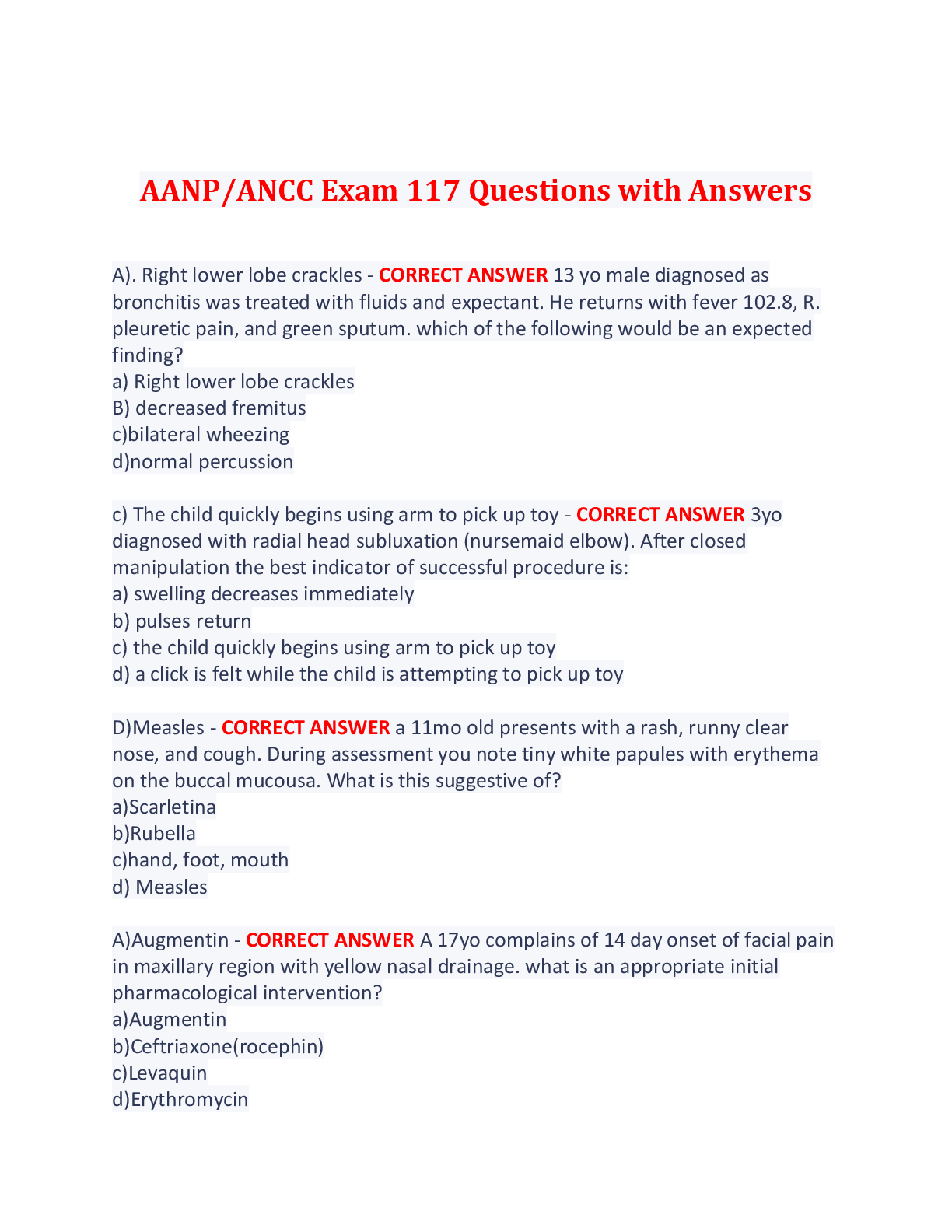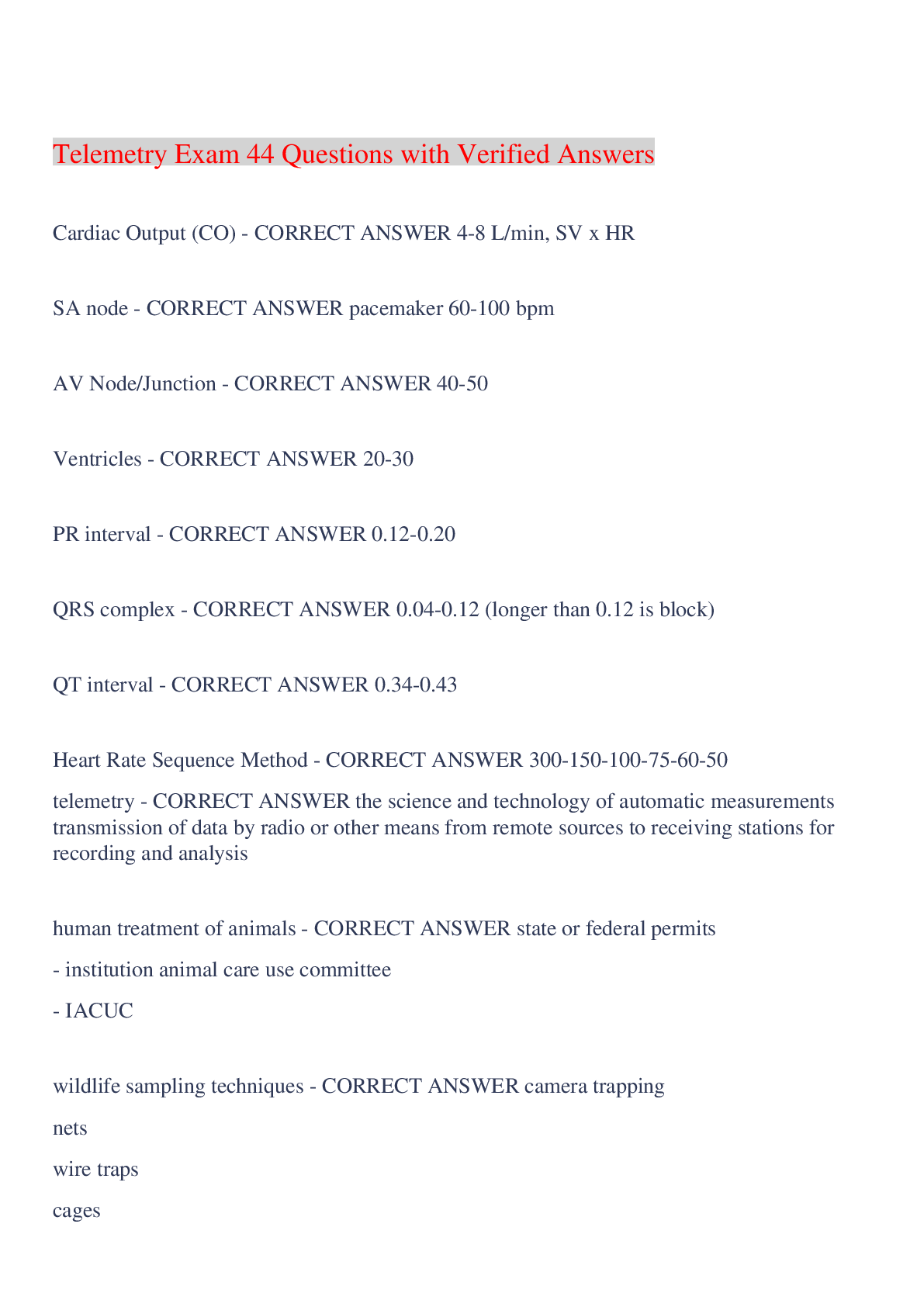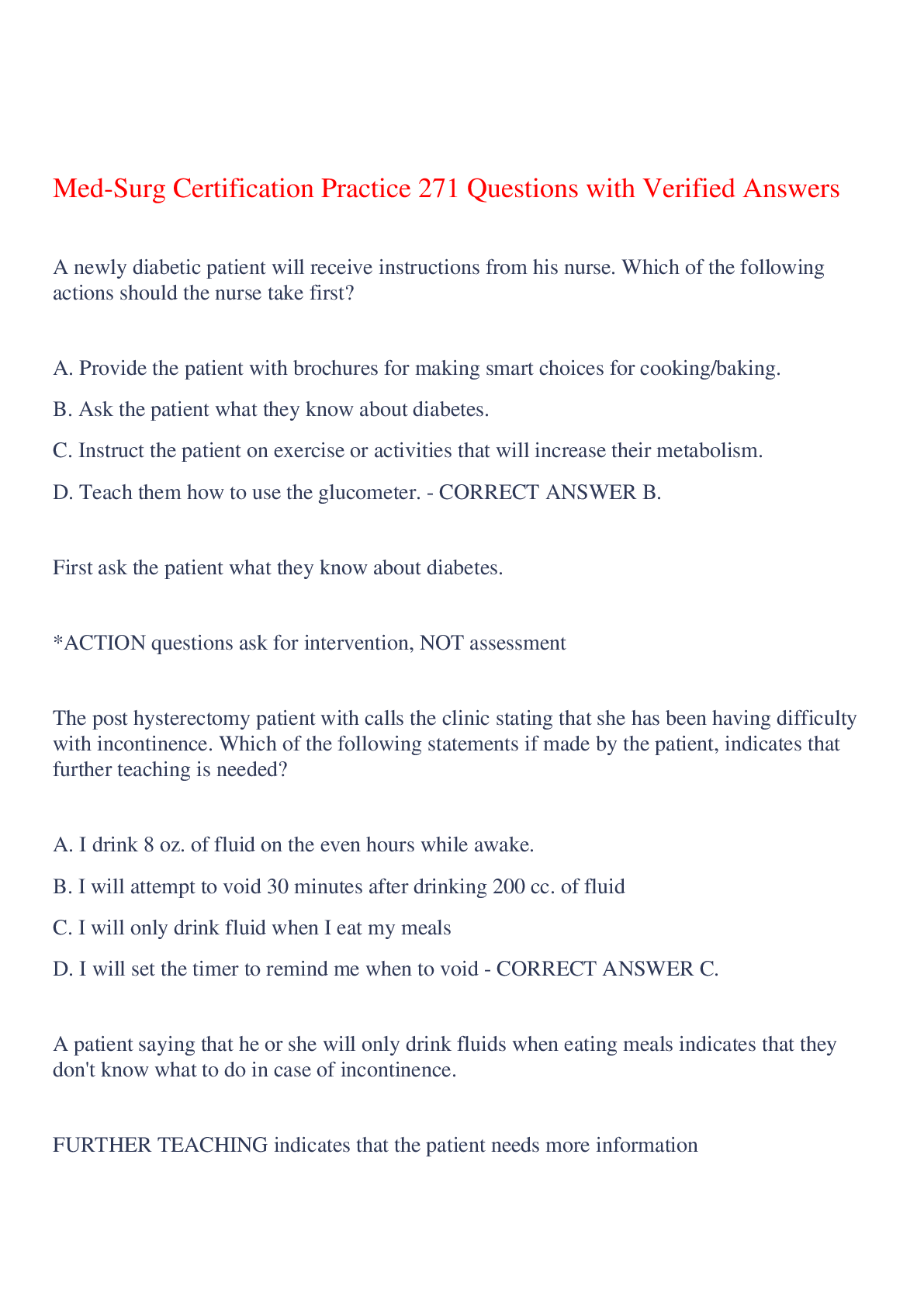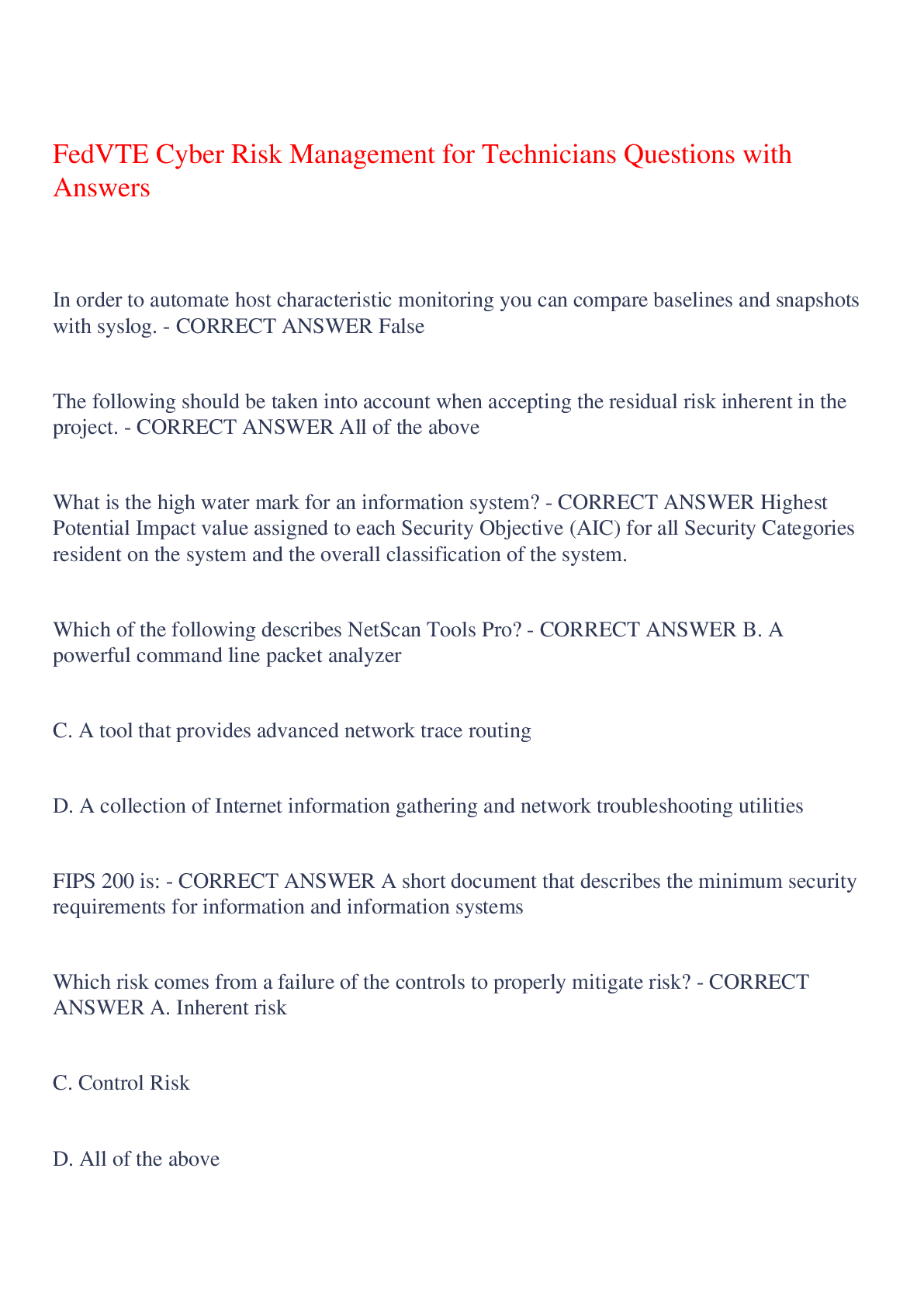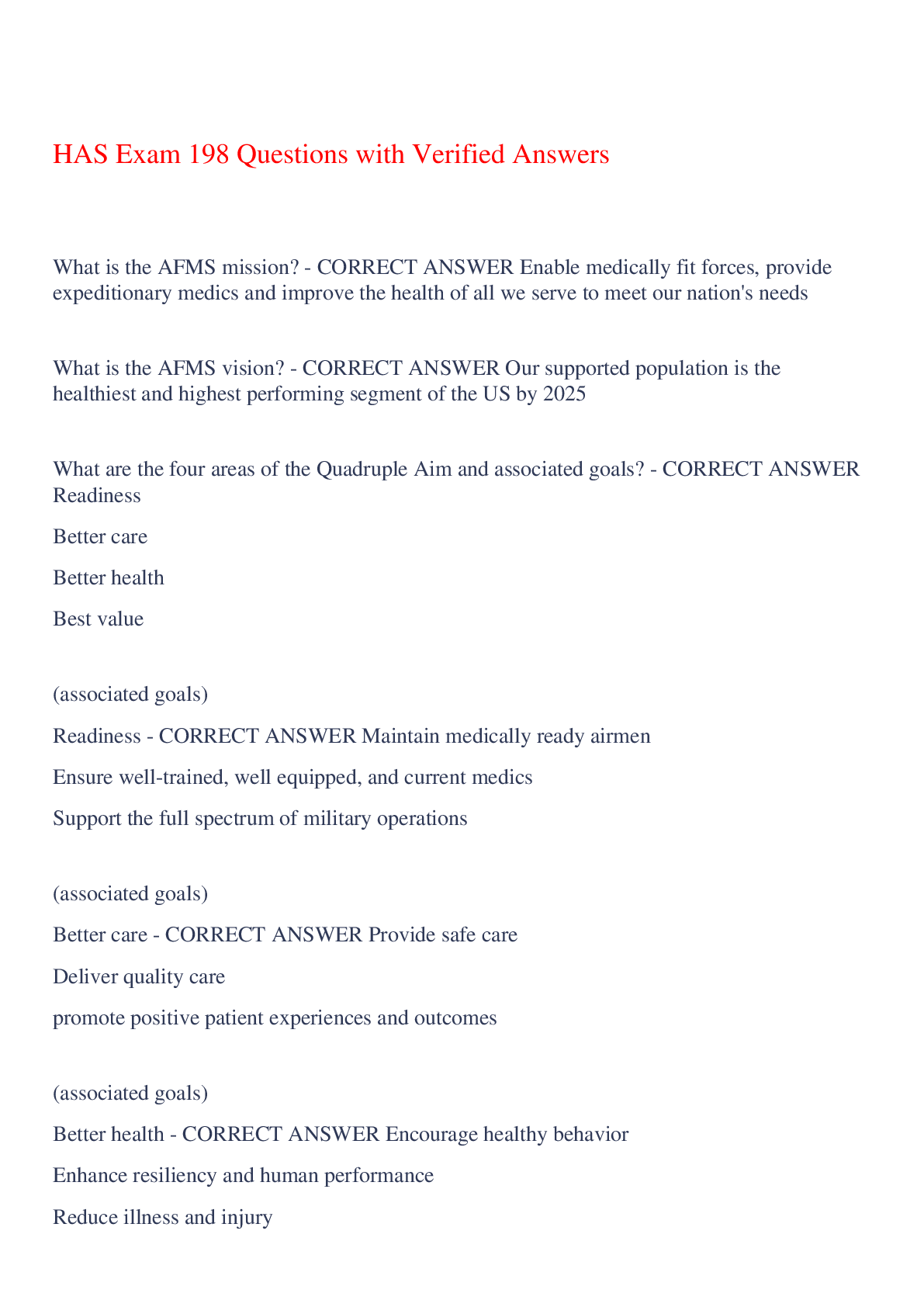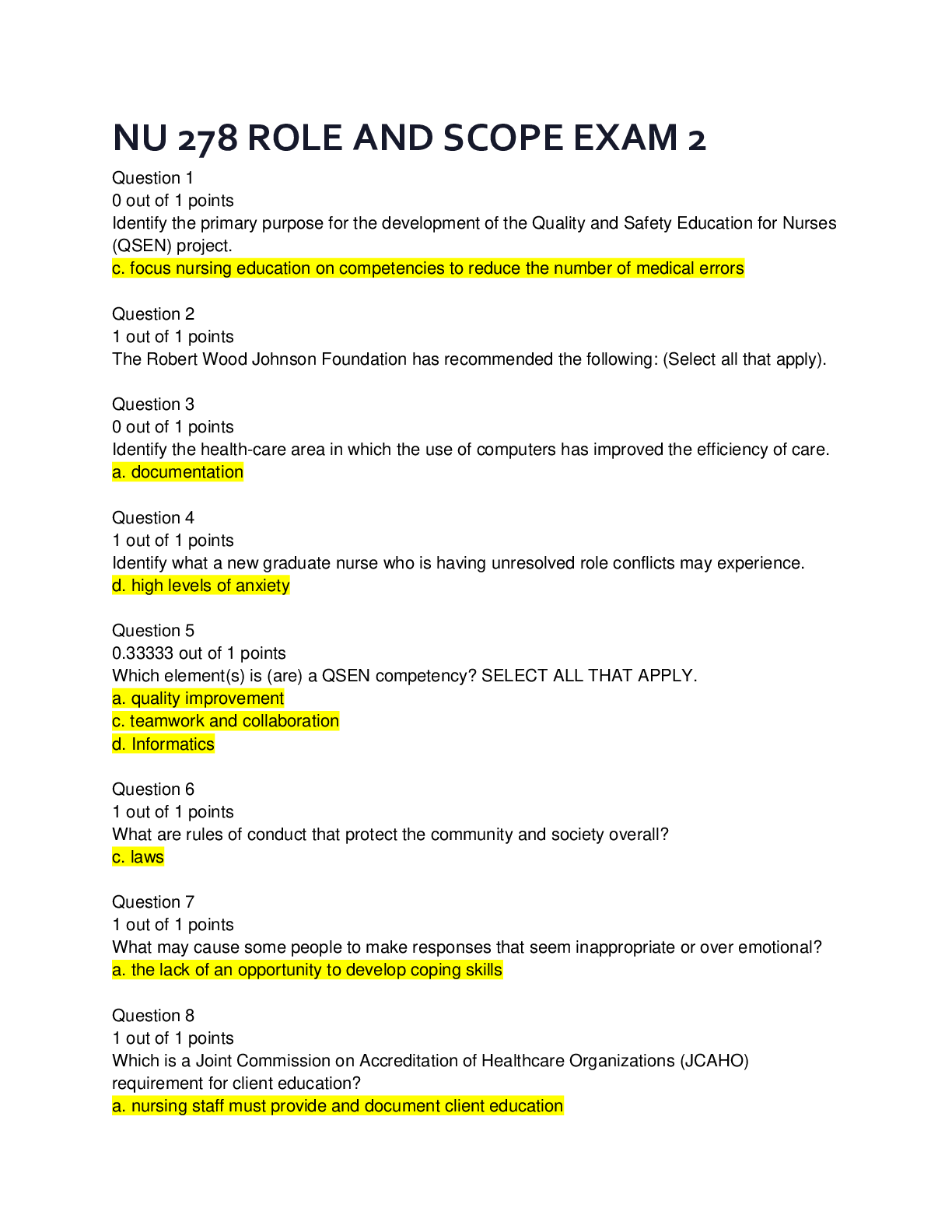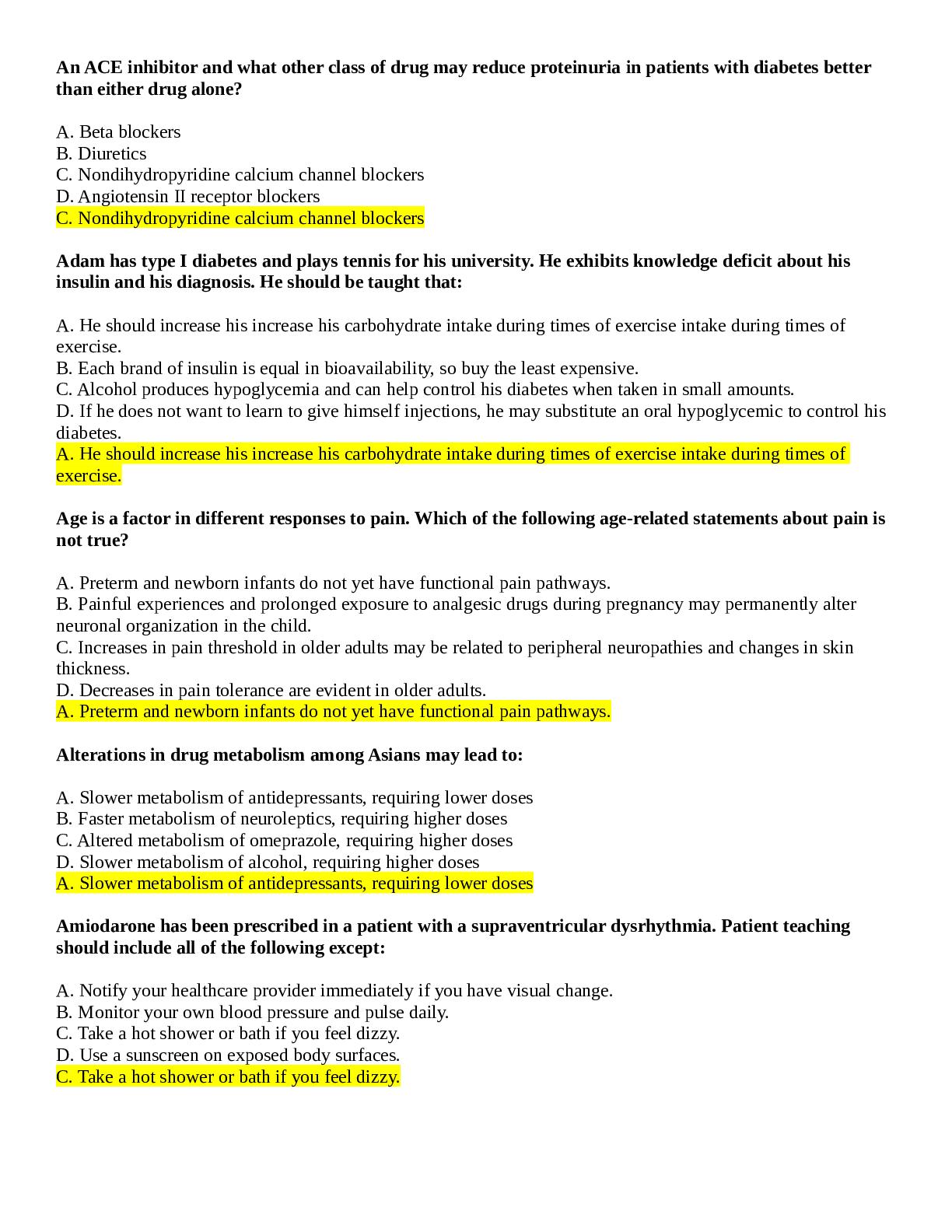NR 504 Exam 2 Questions with Answers 2023,100% CORRECT
Document Content and Description Below
NR 504 Exam 2 Questions with Answers 2023 Water Quality - CORRECT ANSWER Specific characteristics of water defined within the context of its intended use Polluted Water - CORRECT ANSWER When i... mpurities in water are sufficient to render the water as unacceptable for its intended use Compensation Point - CORRECT ANSWER Depth where photosynthesis equals respiration (below this depth photosynthetic organisms can't survive) Limnology - CORRECT ANSWER Study of lakes Lake Formation Methods - CORRECT ANSWER 1) Tectonic Activity-Volcanoes, Depressions formed by movement of Earth's crust 2) Rivers (oxbow lakes) 3) Glaciers- formed from gradual erosion and deposition to advancing/retreating glaciers***Great Lakes 2 Systems of Lake Ecological Zones - CORRECT ANSWER Light and Temperature Littoral Zone - CORRECT ANSWER Extends from shore until not enough light to support rooted plants (light) Limnetic Zone (pelagic) - CORRECT ANSWER area beyond influence of shore, photosynthesis occurs by floating microorganisms (light) Profundal Zone - CORRECT ANSWER area of lake where not enough light penetrates for photosynthesis (light) Lake Ecological Zone based on Temperature - CORRECT ANSWER Summer-Stratification (layers) due to temperature differences. Warm less dense water remains at surface--due to density, waters do not mix Fall-turnover of water occurs when density at surface increases, results in mixing of nutrients and dissolved oxygen Summer Stratification--Epilimnion - CORRECT ANSWER mixed layer top/surface water warm/less dense dissolved oxygen is high photosynthesis is dominant Summer Stratification--Metalimnion - CORRECT ANSWER Middle layer, steep thermal gradient (thermocline) Summer Stratification-- Hypolimnion - CORRECT ANSWER Deeper water, cold/dense Decomposition dominates low dissolved oxygen Great Lakes - CORRECT ANSWER HOMES Largest system of fresh surface water on earth (~18%) Vulnerable to pollution Outflows less than 1% of volume Wetlands - CORRECT ANSWER Areas of land inundated by water enough to affect soils (hydric) and plants (hydrophytes) Transitional land between terrestrial and aquatic ecosystems Water table is near or at the ground surface or land is covered by water Hydroperiod - CORRECT ANSWER Seasonal pattern of water level in a wetland Importance of Wetlands - CORRECT ANSWER -cleanse polluted water Prevention of floods Protection of shorelines Recharge of aquifers Wildlife habitat Maintain plant and animal diversity Carbon Storage Central and South Florida (C&SF) Project of 1948 - CORRECT ANSWER 1947- 108 inches of water fell on South Florida and ****d everything up Created 720 miles of levees, 1000 miles of canals, 16 pumping stations, 200 water control structures Positive Impacts: Reduce flooding, increased water supply, sugar cane production, water management for SF Negative Impacts: reduced Everglades by 50% Surface flows reduced by 70% Water quality, quantity, and timing modified, loss of habitat, deleterious effects on estuaries and citrus crop Everglades Restoration Project - CORRECT ANSWER Capture most diverted water and deliver to areas where needed. Used mostly for environmental restoration and some for farmers and urban areas. Restore quantity, quality, and timing of water flows Importance of Soil Water Movement - CORRECT ANSWER Irrigation Recharge zones for groundwater Soil as a filter Storage of wastes Flood Predictions Soil - CORRECT ANSWER Porous medium Consists of: Solid (sand, silt, clay, OM) Liquid(water) Gas(air, water vapor, CO2) Porosity - CORRECT ANSWER Amount of void space in a soil Volume of pores / Volume of soil (solid +pores) Soil Moisture Zone - CORRECT ANSWER Region of soil water available to Plants Intermediate Zone - CORRECT ANSWER Transition Zone (water content begins to increase) Capillary Fringe - CORRECT ANSWER Pores are filled with water but water is held by capillary forces Saturated Zone(groundwater zone) - CORRECT ANSWER Pores are filled with water and water moves due to gravity Soil Moisture Properties - CORRECT ANSWER Saturated - all pores are filled with water Volumetric moisture content =porosity Unsaturated= pores contain air and water. Volumetric moisture content < porosity Volumetric Moisture Content - CORRECT ANSWER Volume of water / Volume of soil (cm3/cm3) Equal to porosity when soil is FULLY saturated Field Capacity - CORRECT ANSWER Amount of water held against gravity Water in soil after saturating then draining Permanent Wilting Point - CORRECT ANSWER Soil moisture content at which water is no longer available to plants Available Water (Soil) - CORRECT ANSWER Difference between field capacity and wiling point Forces driving Water movement through soil - CORRECT ANSWER Gravity (pulls water to center of Earth) Capillarity (Rise of water in small tubes against force of gravity) Osmotic Tensions (plant uptake of water) Infiltration - CORRECT ANSWER Movement of rain and melting snow into the soil Rate: Rate at which water enters the soil Capacity: Maximum infiltration rate Infiltration Capacity - CORRECT ANSWER Max. infiltration rate Initially very high in dry soils Decreases as soil gets more wet When reduced below rainfall rate water will accumulate on surface leading to runoff P-Rate > I-Rate Factors Affecting Infiltration Rates - CORRECT ANSWER -Physical Factors of soils (soil permeability, macropores) -Biological (organic content, presence of roots, vegetation presence/type, animal burrows) -Meteorological (storm intensity, antecedent moisture conditions, temperature-water viscosity increases as temp. falls) -Anthropogenic (urbanization, vegetation removal, agricultural methods) Infiltration in Forests - CORRECT ANSWER Very high due to organic matter Rarely does precipitation exceed infiltration Infiltration in Agriculture - CORRECT ANSWER Variable- depends on tilling practices, crop type, grazing Infiltration in Urban - CORRECT ANSWER Low due to impervious cover, promotes flash flooding Groundwater - CORRECT ANSWER Water below the water table Pores are saturated Water flows by gravity (capillary forces are not important) Depth of groundwater varies Aquifer - CORRECT ANSWER Water bearing layer of soil that contains and transmits significant amount of water unconsolidated- sand and gravel Consolidated-limestone, fractured bedrock Aquiclude (aquatard) - CORRECT ANSWER Contains significant water but does not transmit it Low permeability media, clays, shales Confining Unit Aquifuge - CORRECT ANSWER Does not contain or transmit significant quantities of water Confining unit Unconfined Aquifer - CORRECT ANSWER Water table is the upper boundary Water table - CORRECT ANSWER Where pores are filled with water and water pressure is atmospheric Confined Aquifer - CORRECT ANSWER Bounded on top by a confining layer Fluid is under pressure Artesian well-well in which water reaches surface without pumping Perched Aquifer - CORRECT ANSWER Localized zone of saturation associated with a confining layer How does groundwater move? - CORRECT ANSWER Rate at which water moves through aquifers is a function of: -Force doing the pushing (hydraulic head gradient) -The ease with which the soil will allow the water to move (hydraulic conductivity of permeability) q=K(h1-h2/L) Hydraulic Gradient - CORRECT ANSWER Gradient in water table (dh/dl) What can increase groundwater flow rates? - CORRECT ANSWER -increase force doing the pushing (gradient) -increase permeability (decrease resistance to flow) Why is calculating groundwater flow important? - CORRECT ANSWER Avoid over pumping (aquifer mining) Assess pollution sources ***Woburn, MA case study (A Civil Action) Flow direction and flow rate were crucial factors in the trial Calculating Groundwater Flow - CORRECT ANSWER Darcy's Law Q=KA(h1-h2/L) where Q=discharge (L3/T) K = hydraulic conductivity(L/T) A= Area (L2) h/l= hydraulic gradient (L/L) Calculating Groundwater Velocity - CORRECT ANSWER v=q/n where v=velocity n=porosity q=groundwater movement How are aquifers recharged? - CORRECT ANSWER Recharge Areas- downward movement of water through soil zone to saturated zone unconfined (unsaturated zone above water table) Confined (distant uplands) Groundwater Recharge Types - CORRECT ANSWER Passive (rainfall) Induced (recharge from losing streams, lakes, or wetlands) Artificial (induced recharge by humans) Discharge Areas - CORRECT ANSWER Outward movement of water across water table point where water table intersects the ground surface 'Gaining' streams, lakes, wetlands, springs 2 Problems of "A Civil Action" Case - CORRECT ANSWER 1) City wells not activated for flow tests 2) explanation to jurors using q and velocity were too difficult Specific Yield - CORRECT ANSWER Volume of water produced per volume of aquifer drained Determines how much water an UNCONFINED aquifer yields Storativity - CORRECT ANSWER Volume of water produced per volume reduction of potentiometric surface Water obtained by expansion of water and compression of aquifer materials (water pressure falls, and it stops pushing apart the inorganic aquifer particles) Determines how much water a CONFINED aquifer will yield What happens to a water table when water is pumped from aquifer? - CORRECT ANSWER Cone of depression is formed water flows towards well to replace water that was pumped out Shape is a function of: 1) permeability (conductivity) 2) Storage (yield) Radius is determined by how long pumping occurs Will continue to expand until recharge is increased or discharge is decreased Much more extensive in confined aquifers Current issues in GW management - CORRECT ANSWER overlapping of cones of depression land subsidence salt-water intrusion in coastal areas Reduced streamflow or "sucking pollution upstream" Ogallala Aquifer - CORRECT ANSWER Loss in saturated thickness Withdrawl rates exceed recharge rates by 10 to 50 times Water level has been lowered as much as 100 to 200 ft Water quality degradation Safe Yield - CORRECT ANSWER How much water can be removed safely from an aquifer? Historically thought to equal recharge rates, but if : Change in storage=inputs-outputs Recharge-discharge storage=0 and then add pumping, you are depleting storage constantly. So, discharge must decrease SHOULD be defined as "how much of the aquifer discharge we can capture without adversely affecting the environment USA Springs Bottling Plant (Nottingham, NH) - CORRECT ANSWER requested to withdraw 310,000 gal/d -requires a field investigation and pump test to approve this request Argument For: Provides jobs, 30 other withdrawal operations in NH that are larger, "will not affect local hydrology" Against: incomplete understanding of hydrology, 10 days of data extrapolated to 180 days (assumes no annual variability), contamination in wells Dams - CORRECT ANSWER Structures to store and redirect river water for a variety of purposes Benefits: Cheap, clean electricty, flood control, recreation, drinking water, irrigation water Drawbacks: Displacement of people, silting of reservoir, failure and flooding, disruption of pulse dynamics in river, retention of important nutrients and sediments, interference with fish migration paths, temp. and DO impacts downstream Dam Removal (Decommissioning) - CORRECT ANSWER National movement ro remove dams with few to no benefits cost need substantial improvements for re-licensing by FERC Edwards Dam in Maine- FERC denied new permit to expand dam, ownership overturned to State, removed North Platte River Project - CORRECT ANSWER -Fed by mountain streams rising in the Rocky Mountains Water is stored and used for irrigation and power -Dams & diversions are interspersed along River -Require close coordination of operations (complicated by agreements & laws governing water rights) Problem: -4 Federally listed species - Sandhill Crane, Least Tern, Piping Plover, Pallid Sturgeon -Several state listed species (from bugs to the Bald Eagle) -Loss of natural floodplain and adjacent wetlands Klamath River Project - CORRECT ANSWER -The Klamath Basin was developed for agriculture at the turn of the century -Depended on (and funded) water projects -Water is stored and used for irrigation and power (downstream) and support of species -Regional droughts in 2001 triggered use of the ESA to halt irrigation -Coho Salmon and 2 species of suckers -Farmers were outraged Salmon die-offs in 2002 Irrigation continues with: -Water Bank Program -Fish screen at 'A' canal Removal of a dam Sources of Stream Pollution - CORRECT ANSWER Point Source: Direct Discharge into Water (sewage treatment, dumping toxins) Non-Point Source: Indirect discharge into water (agricultural runoff, urban runoff) Suspended Contaminants - CORRECT ANSWER Undissolved solids carried by water (sediments, OM, bacteria) Dissolved Contaminents - CORRECT ANSWER Solvent: Water (does the dissolving) Solute- substance being dissolved(salt)---Dissolution (ions form bonds with water) How do we quantify amount of substance (pollutant) in water? - CORRECT ANSWER Concentration - mass of substance per unit volume of solution (g/L, mg/L, ug/L, ng/L) Benefits of Good Water Quality - CORRECT ANSWER Decreased impacts to health and property Reduced cost of water treatment Increased value of property near water Economic Development Increased fisheries revenues Recreation industry unimpaired ecosystem services Salinity - CORRECT ANSWER Cations/Anions Freshwater= <1000 ppm of total dissolved solids Drinking water <600 ppm Temperature - CORRECT ANSWER Sources: Discharge from power plants, removal of vegetation next to stream Effects: increased rates of chemical reactions, negative impacts on stream flora nd fauna, increased biological activity, increased respiration and oxygen demand pH - CORRECT ANSWER Alkaline= High OH+ concentrations Acidic= high H_ concentrations Kw= [H+] * [OH-]/H20 Hardness - CORRECT ANSWER Total amount of dissolved calcium, magnesium, and iron present in water Hard- build up of scale, lack of soap lather Soft- difficulty rinsing Turbidity - CORRECT ANSWER Suspended sediments Consists of inorganic (silts and clays) and organic matter Sources: Natural erosional processes, poor land management practices (removal of vegetation) Envi. Concerns: Fish gill abrasion, increased treatment costs, smothering of benthic communities, reduction in light penetration, reduces photosynthesis Reduction in light penetration (turbidity) - CORRECT ANSWER -diminishes exponentially with depth (reflection and absorption) When light is absorbed it is changed to heat Light penetration will determine distribution of organisms and heat How is light penetration measured? - CORRECT ANSWER Photometer, secchi disk, radiometer Governed by Beer's Law Iz=I0e ^(-ʎ z) Where Iz= irradiance at depth x I0= irradiance at water surface ʎ = extinction coefficient z=depth inorganic compounds - CORRECT ANSWER carbon free, not derived from living material, easily dissolve in water Minerals (salt), Metals (lead, arsenic) Organic Compounds - CORRECT ANSWER Contains carbom, derived from living organism Tend to not dissolve well Natural (oil, decomposing OM) Synthetic (pesticides) Biodegradable (can be broken down easily biologically) Non-Biodegradable (resistant to biological breakdown) Atrazine - CORRECT ANSWER Most heavily used pesticide in US (Corn) found ins streams, lakes, groundwater Alters sexual development in frogs Integrated Pest Management (IPM) - CORRECT ANSWER Focus away from chemical-only solution Process: Determine needs Natural predators/parasites mechanical removal Pesticides (natural, synthetic) Determine outcome and further need DDT - CORRECT ANSWER Used to kill mosquitoes Banned in 1921, thinning of egg shells in endangered raptors Arsenic - CORRECT ANSWER Anthropogenic Sources (agricultural chemicals, wood preservatives) Natural Sources (found in primarily sulfide minerals, granite bedrock) [Show More]
Last updated: 2 years ago
Preview 1 out of 16 pages
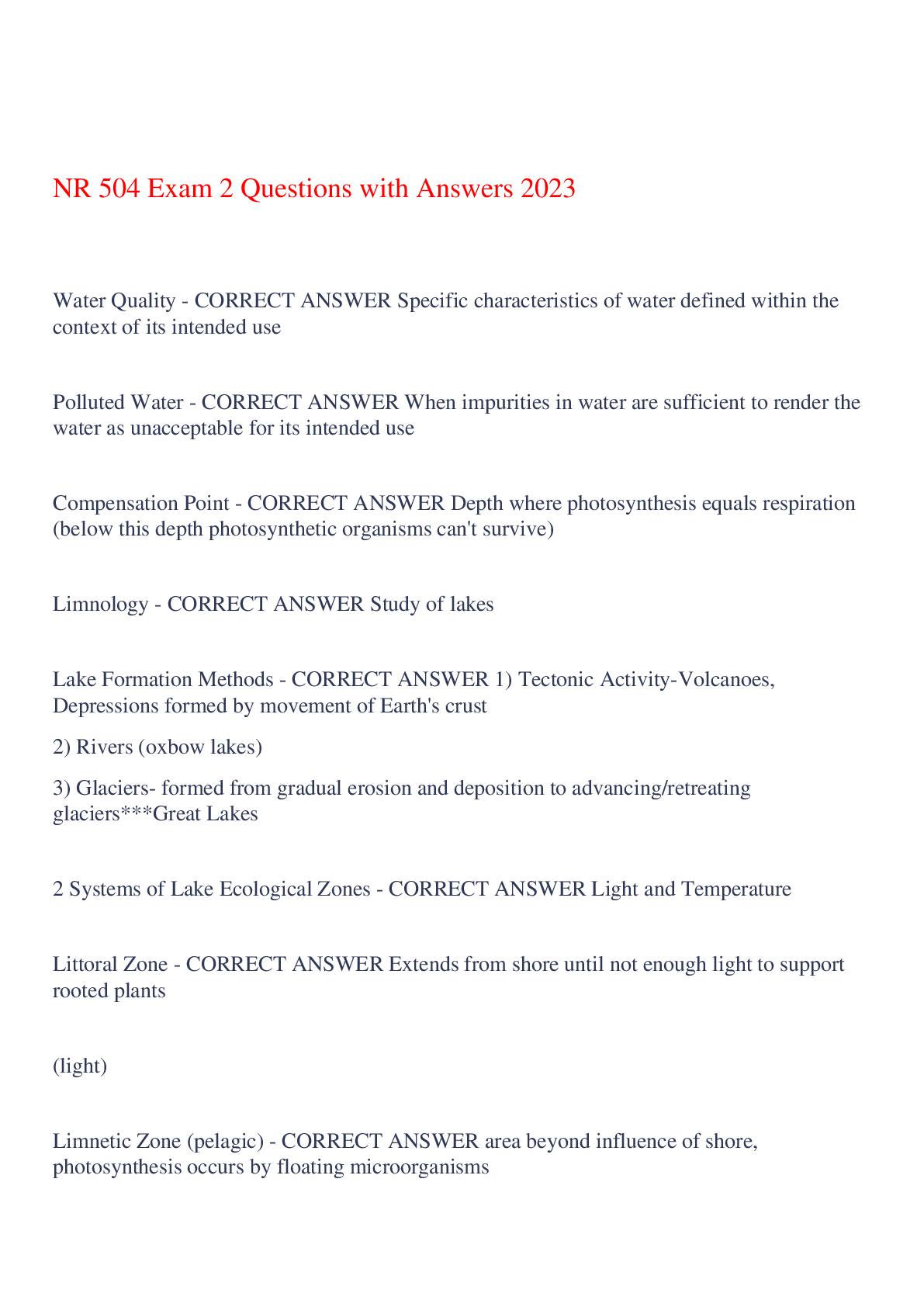
Buy this document to get the full access instantly
Instant Download Access after purchase
Buy NowInstant download
We Accept:

Reviews( 0 )
$8.50
Can't find what you want? Try our AI powered Search
Document information
Connected school, study & course
About the document
Uploaded On
Jul 09, 2023
Number of pages
16
Written in
Additional information
This document has been written for:
Uploaded
Jul 09, 2023
Downloads
0
Views
73


